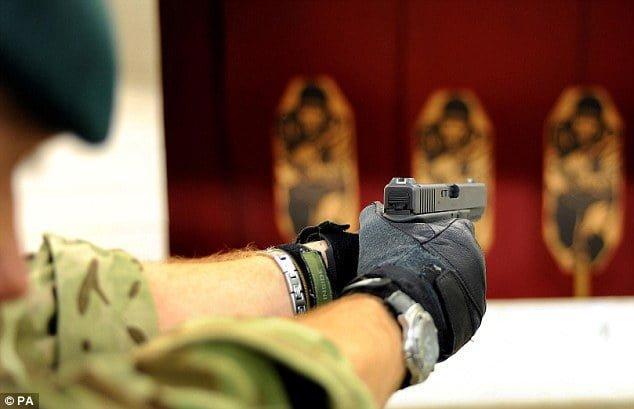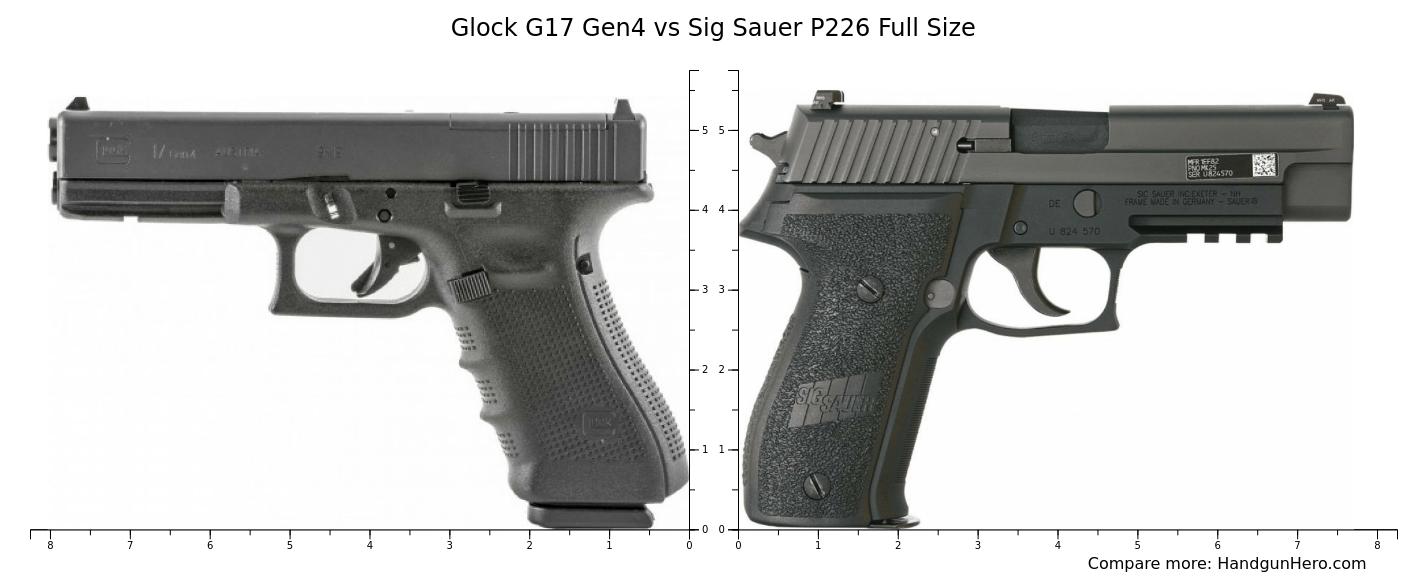The comparison of the Glock 17 vs. SIG P226 as the service-duty pistol should not be viewed in terms of the better because it is a subjective term. Both guns are well thought out and have rugged defensive tools.
Glock 17
The Glock 17 is one of the most popular service-duty pistols ever produced. It appeared in the early 1980s and immediately hit the headlines. It breaks all the rules at the time; Glock is primarily made of plastic. The pistol design made no concessions to the popular view of what a pistol should look like.

Upside
It is relatively cheap-US $550-$600. It has a simple manual of arms- once it is loaded and in service, draw, aim, trigger press. The trigger pull and trigger action remain the same for every shot. Rinse and repeat until you do not need to fire anymore. There are no extraneous levers or controls. It is rugged, reliable, has good capacity in either form, is easy to customize, and easy to maintain, and there are enormous amounts of aftermarket parts available to modify or improve performance and utility for a particular user. The plastic frame allows significant modifications; you can get the grip custom reshaped and shrunk slightly as well as stippled for a better hold, and it’s possible to even create a flared magazine well for faster loading.
Downside
The trigger is crunchy, gritty, and long, about 8 pounds. (Edit: Some trigger connector combinations give a much better and smoother trigger function, circa 5.5- pounds- my Glocks have triggers that are as rough as an East Texas gravel road). The Glock grip angle is awkward, and pointing is unnatural for most firers. The pistol grip itself is very straightforward; it has been compared to clutching a 2×4 piece of lumber.
People with small hands or short fingers often have to resort to “side gripping” to access the trigger; this makes the gun (when fired right-handed) recoil by twisting up and to the right, significantly increasing the time for follow-up shots and making Control more difficult. The factory plastic sights are terrible, and the glue holding them fails; I have had a rear sight fly off in the middle of shooting a string.
SIG Sauer P226
The SIG Sauer P226 is a great pistol that the Navy SEALs adopted. For years it was their favorite service-duty pistol. Despite the fact that they are trading it for Glock 19, it is still one of the most reliable service-duty pistols in the Navy.

Upside
Both models are accurate and well made. A metal SiG is rugged and reliable. Being hammer-fired, they are less sensitive to ammo loaded with overhard primers. They have excellent factory sights, and the all-metal construction gives a “heft” that builds confidence. Capacity is pretty much up to modern standards.
The manual of arms of the Double Action/Single Action system is simple: once it’s loaded and in service, the firer draws, aims, and presses the trigger through its 11-pound Double Action trigger pull, which cocks the hammer and then releases it to fire the first shot; subsequent shots are fired with a crisp and short 5-pound Single Action trigger pull. The SiG grips fit the human hand, and most shooters can avoid side gripping.
Downside
Metal Sigs are pricey, the US $960-1250, and up depending on model and trim. Metal Sigs tend to be heavier than comparable Glocks, although some people consider this a feature, not a bug. The trigger pull changes from first to subsequent shots; many people find this disturbing and have to “shift grip” to accommodate the two different types of trigger action.
When firing is finished, the pistol must be manually “decocked” with the decocking lever before reholstering; that’s a step in the manual of arms that the Glock doesn’t have. Learning to manage the SiG trigger for the best accuracy requires more training time, although it is readily accomplished.
Final verdict: Glock 17 vs. SIG P226
My choice. SiG, hands down. I train people using Glocks; they are indeed the lowest common denominator and are certainly adequate for personal defense tasks. Given my druthers and making a decision for myself, I would prefer the handling and ergonomics of the SiG. The SIG P227. That’s a SIG P226 chambered for .45 ACP.

As far as this comment “ Floxk is the tactical standard globally…for a reason.” large purchasing decisions most often based on budget not quantity. G’s are good but not equal quality to a metal Sig. they’re just facts. If you’re Glock fanboy status. You probably can’t afford or too cheap to buy a Sig. honestly you can’t fault their performance.